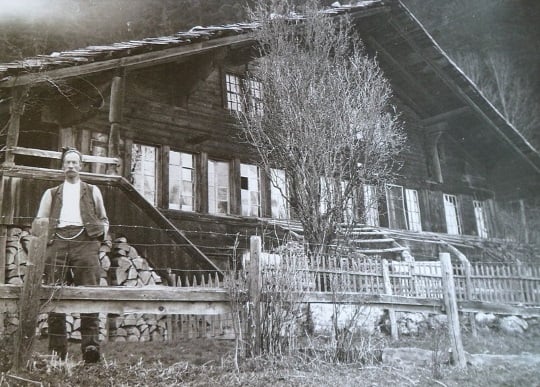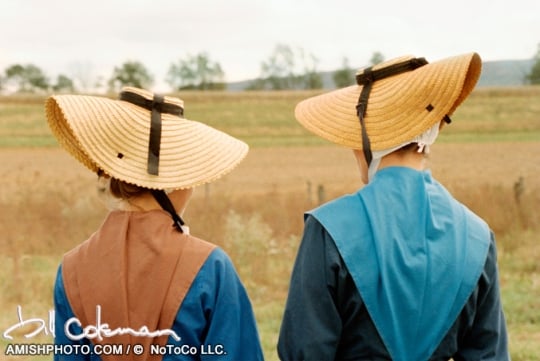The Amish Dress Code
In today’s guest post, Suzanne Woods Fisher looks at the development of Amish plain dress, and the role played by Amish founder Jacob Amman. As Suzanne explains, Amman would have known something about clothing.
—
Why do the Amish dress the way they do? Simple clothing identifies the Plain People as set apart, as individuals belonging to a larger whole, the way a military uniform sets apart a soldier. But it might surprise you to learn that distinctive clothing didn’t play a role in the early years of the Anabaptist movement. In order to understand how the “dress code” evolved, we first need to meet Jacob Ammann, the man who founded the Amish branch of the Anabaptist movement.
In many parts of Europe in the 17th century, clothing was regulated by “sumptuary laws,” sets of laws that identified social class and prevented extravagance. As farmers and peasants, the Anabaptists wore simple, practical clothing that fit their status. Strict adherence to distinctive clothing didn’t begin to emerge until Jacob Ammann emerged on the Anabaptist doctrinal scene. And interestingly, Jacob Ammann was a tailor.
Jacob Ammann, born in 1644 in Switzerland, grew up as the son of a tailor. Like most sons of the time, Jacob followed in his father’s footsteps. It’s believed that he converted to Anabaptism in 1679, and at some point became an ordained minister, then later a bishop. Troubled by what he considered overly tolerant views in the church, Ammann stridently advocated for renewal. Those reforms led to a split in 1693, and as the faction grew, his followers became known as the Amish.

As a tailor, Jacob Ammann would have been very familiar with sumptuary laws. Tailors were obligated to tell customers what kinds of garments they were allowed to wear, and they could be fined if they made clothing that contradicted those laws.
As the leader of the new faction, Ammann enforced the wearing of traditional, simple clothing. He condemned the trimming of the beard and the wearing of fashionable clothing as worldly, and “anyone desiring to do so” he said, “shall be justly punished.” The Amish became known as Häftler (hook-and-eyers) and the Mennonites were the Knöpflers (button people).
And then Jacob Ammann disappeared.
The last he was heard of was in 1712. A few sketchy assumptions linger on about what happened to him: He was expelled from the region in France where he lived. Perhaps he went into hiding to escape persecution. It is known that his involvement in church matters had diminished long before 1712. In 1730, Amman’s only daughter told officials of Switzerland that her father was dead, but the actual date of his death has remained unknown.
Despite a lack of leadership, despite persecution and oppression, the Amish faction continued to grow. It was small, not centrally organized, and scattered in parts of France, Switzerland and Germany.
As the New World beckoned, the Amish started to immigrate. The first group that was large enough, complete with ordained leaders, sailed on the Charming Nancy ship in 1737. For the next thirty years, the Amish kept migrating to America. With them came variations of clothing from their regions. And they also were influenced by those with whom they rubbed shoulders in colonial America.
Here’s an interesting example: Nebraska Amish women, some of the earliest Amish immigrants, did not wear bonnets. It’s thought that the adoption of the black bonnet was borrowed from the Pennsylvania Quakers.

And another example: An Amish woman’s prayer cap, essentially similar to those worn in the Palatinate (Rhine Valley) in the 1700s, has been tweaked and trimmed—from the Lancaster organza “heart” to the stiff cap of many Ohio Amish.
One of my favorite stories about the developing distinction of Old Order Amish clothing comes from the 18th century, in a little town in Ohio. A young German immigrant wore to church his beloved red Mutza, a color of a coat common in the Old World but frowned upon in the New World. That red Mutza caused all kinds of church unrest—to the point where communion itself was stalled until the issue was resolved. The true story (which can be read in Heart of the Amish, which releases in May) had so much meaning to it that I wove it into Anna’s Crossing, a novel about the first Amish who came to America on the Charming Nancy.
Today, distinctive styles of Amish clothing continue to evolve. Recently, an Amish church in Independence, Iowa agreed to permit boys to wear wool caps instead of black hats during long, bitter winters. To those of us on the outside, it seems like such a trivial thing. Why not let a boy wear a warm woolen cap to school? But to the Amish, like so many of their choices, it’s a decision they make slowly, cautiously, and together.
Suzanne Woods Fisher is the bestselling author of ‘The Stoney Ridge Seasons’ and ‘The Lancaster County Secrets’ series, as well as nonfiction books about the Amish, including Amish Peace. She is a Christy award finalist and a Carol award winner. Her interest in the Anabaptist culture can be directly traced to her grandfather, who was raised in the Old German Baptist Brethren Church in Franklin County, Pennsylvania. Suzanne hosts the blog Amish Wisdom, and has a free downloadable app, Amish Wisdom, that delivers a daily Penn Dutch proverb to your smart phone. She lives with her family in the San Francisco Bay Area. You can find Suzanne on-line at suzannewoodsfisher.com. She loves to hear from readers!
Primary sources:
Amish Society, 4th ed., by John A. Hostetler (Baltimore: The Johns Hopkins University Press, 1963).
Unser Leit: The Story of the Amish, vol. 1, by Leroy Beachy (Millersburg, Ohio: Goodly Heritage Press, 2011).
The Amish by Donald Kraybill, Karen M. Johnson-Weiner, and Steven M. Nolt (Baltimore: The Johns Hopkins University Press, 2013).








I found this whole posting interesting, but especially the part about the Amish being called Haftlers (hook-and-eyers). One of my uncles (non-Amish) farmed in the 1960’s and 70’s in the Hazleton,Iowa, next to an Amish farmer. When he referred to the Amish, he would often just say, “the hooks” which I thought was somewhat derogatory. So, it was interesting to read that in Jacob Amman’s time, Amish were referred to as “Haftlers” (hook-and-eyers). And, I’m wondering if it was somewhat derogatory, then also. I’m also wondering if the Hazleton area Amish maybe themselves used “Haftlers” when referring to themselves and “Knopflers” (button people) when referring to non-Amish, or similar words.
Hook-and-Eye
Hi Al–
Interesting story about your uncle in Iowa! I wouldn’t be surprised if the term “Hooks” was meant to be derogatory. I know the term “Anabaptists” and, later, “Avoiders” (which was specifically meant for the Amish) were unflattering terms. Thanks for sharing your memory! ~Suzanne
Amish Dress
As a born Michigander I have seen many Amish ladies using straight pins to close their garments. A bit prickly if you as me. I am Amish on my dad’s side but never raised as such.
What an interesting article. Thank-you.
Thanks for stopping by, Harriet!
Hooks and Eyes, Clothing, Hutterites and Amish
When I “joined” the Hutterites as a “novice” member nearly 50 years ago, like the Amish most Hutterites were using hooks and eyes (both men and women), and my first Hutterite jacket had hooks and eyes. I watched this slowly change over the years and today I seldom see hooks and eyes, except for a few elderly men. There are four groups of Hutterites now (five if you include the Bruderhof or six if you include the Prairieleut). Each have some variation in clothing. For some reason unknown to me the Lehrerleut, the most conservative group, was using buttons on their jackets over 50 years ago, although most Schmeidleut and Dariuleut were using hooks and eyes.
Not all Anabaptists were peasants and farmers as the article seems to imply. There were several “intellectuals” in the Anabaptist movements including “professional” people, many former priests, artisans, and “educated” people, especially in the early years. The Hutterites, for example, had their own doctors. Hutterite schools were of such high quality that the nobility sometimes sent their children there to be educated. The movement included a good cross section of society, although the majority likely were tradesmen and farmers.
Hutterites
Terry–Thank you for chiming in and sharing from your firsthand experiences. I’m reading some books about the Hutterites right now. Fascinating! ~Suzanne
A very interesting article.
Dress Code
Thank you, Mark! Means a lot to me to hear that from you. ~Suzanne
Amish dress code
What a great article and very interesting.. It’s always interesting to learn some,thing..
HI Natalie!
Glad you enjoyed the post. The more I learn, the more there is to learn! Warmly, Suzanne
Thanks for sharing this information, Suzanne. I am reading Anna’s Crossing right now — about 2/3 of the way through — and starting to wonder about the red coat . . .
Red Mutza
Hi there, Pam! Hope you like the ending! Let me know. 🙂 ~Suzanne
Wool Caps
The Amish boys in northern Indiana have been wearing wool caps for several years. Interesting that some areas still debate that.
Wool caps
Hi Barb! I’m so glad you mentioned that about boys in Indiana. Interesting slice of life! Thanks for taking a moment to comment. ~Suzanne
Regarding the wool caps in the winter, not only are they warm, but I’ve never had to chase one down after it blew off my head on a windy winter day….
More on wool caps
Grinning, Forest! Stay warm! ~Suzanne
I recall a speaker at an Anabaptist Identity Conference mention that a study of surnames seems to show that Amman’s followers were an independent trend w/in Anabaptism, rather than a split from the greater Mennonite fellowship, as is commonly believed.
I find the history of clothing in regards to Anabaptist and other “plain” sects to be so fascinating. There is a long and beautiful history of Christians of all socio-economic classes deliberately dressing in solidarity with the peasant class. All Christians, even today, can ask themselves the simple question, “Do my clothes/actions/mannerisms/lifestyle say ‘harlot’, or ‘Shepherd’?” It’s really pretty simple.
My husband and I read a book many years ago called “Up Tunket Road,” in which the author had spent time studying agricultural practices in the South Tirol region of the Alps. So much of the culture seemed to perfectly parallel the Amish, including oft repeated phrases like “Alles ist in Ordnung,” or “All is in order.” To me the Amish are an endlessly fascinating blend of Christian faith plus various historic and cultural influences.
Final thought: I am sitting here with a sleeping baby in my lap, next to a warm wood stove, looking out a glass door at snow pouring out of the sky, anticipating a nice cold day for the children (and adults : ) to go sledding tomorrow, followed by highs in the 50’s (spring!!!!) all next week. My children were just looking out the window at their dad pumping water at the well pump, saying, “Doesn’t Dad just look like a giant snow flake out there?!” Could God’s blessings be any greater? I think not in this lifetime. May I be able to praise Him equally in hard times.
Thanks for the interesting read!
Warm Wood Stove
Hi Naomi! You, my friend, have a beautiful way with words! Hope you’re doing something with your God given talent. Thanks for sharing your info about the Anabaptists…I enjoyed it! ~Suzanne
That is a sweet compliment that I never expected to receive. I pray that first, God would give me a loving and uncritical heart that always seeks first to build up others. I’m not there yet!
Thank you, Suzanne.
Watch Caps and Buttons
Nice background Suzanne. Thank-you for the article. Around 12 years ago, I attended an auction in Gap, Lancaster County, Penn. I’ve grown accustomed to Amish customs, both there in Lancaster and in our own local community. What very much surprised me though, were the young Amish men who looked like longshoremen! They wore both dark blue watchcaps and Navy pea coats. The coats were dark blue, so that wasn’t such a surprise, but they prominently featured the double row of large buttons that traditionally grace pea coats! I was very startled, by both the buttons and the watch caps. I hadn’t seen either of those outside my own closets for more than 20 years. I’d certainly never seen them before around the Amish communities. Its another sign that the Amish aren’t frozen in time, but just evolve more slowly than the rest of us, even me.
Longshoremen-look
Hi Kenneth! Loved your remark–both about the look of the Amish men as longshoremen and also your insight. Made me smile! Thanks for taking a moment to read the post. Warmly, Suzanne
GREAT article Suzanne!
What I would like to know is, if they were known as hook and eyers – where did the practice of pinning their clothes together come from?
By the way Suzanne, Anna’s Crossing is probably your best book yet! Can NOT wait for more in the series!
Pinning instead of hooks and eyes?
I’m wondering if any of the Amish orders are still pinning their clothes together rather than hooks and eyes? The last time I saw this was a few years ago on a visit to the Old Order River Brethren in Iowa. They were still pinning their clothes together.
In our community, women commonly use pins for their aprons and other clothing. I’ve never witnessed men using pins. Here, men have used the small buttons normally associated with men’s shirts for their own shirts. Buttons are used for suspenders and trousers, while hooks and eyes are retained for coats or jackets.
I have an Amish friend in Holmes County and she uses straight pins in her clothes. I’m pretty sure I would have scarred up arms from accidentally brushing my arms against my top. Maybe you get used to not brushing against them? Ouch…
Amish grouops near Plattville, Wisconsin use pins
The Amish I knew in the area of Platteville, Wisconsin were very conservative. The women used pins to hold dresses together, but the men wore shirts with buttons. They sewed the men’s trousers; they did not wear store bought jeans. Likewise the boys’ trouser’s & jackets were home sewed, as were the women & children’s cloths. Most were farmers & used teams of 4-6 big beautiful draft horses to pull farm equipment, feeling it did less damage to the soil than did tractor’s where the weight is consintrated on just the wheels. The women’s vegetable & flower gardens were large and well tended. The people were friendly, the whole family had chores, and I miss driving them to stores & school as well as discussing God with a few. They were good neighbors!!!
Pinning
Hi JC! Thank you for your kind words about “Anna’s Crossing!” So glad you’re enjoying the story. I loved it, too–thoroughly enjoyed researching it.
As for the history of pins on women’s clothing…interesting question! I’m going to have to “pin” that down with more research (oh…bad pun!).
Thanks for stopping by, JC.
Warmly, Suzanne
More clothes, more laundry!
Hello again, Suzanne!
I, too, am at the point in Anna’s Crossing where I wonder about the red coat. I’ve “survived” the seasickness, but felt very irritated with the flour & laundry episode! I was imagining a sticky, gooey mess. You are really making me “work” to get through this book! (I felt as though I, myself, was washing & hanging out those clothes on the ship!)
Very interesting about Jacob Ammann being a tailor! (I can’t help but wonder what influence he’d have had on Amish clothing if he had been a carpenter or cook, etc.)
Thanks for your research, which makes your books so compelling!
Alice Mary
Laundry
Hi Alice Mary!
Your comment made me laugh…not many people have mentioned that flour episode! Glad you are enjoying the book. Thanks for stopping by. Warmly, Suzanne
Jo-anne, from Winnipeg Manitoba
Thank-you Suzanne
This article is fascinating, Thank-you for taking the time to research everything ; then taking even more of your time to share it with all of us.
I am still curious in the delicate white prayer caps, worn by the women & girls. Some of them seem to be made from different materials. The nearly opaque ones, what material are these made from? ( such a delicate cloth; yet, it looks stiff & strong.)
White Prayer Caps
Though I’ve observed Amish women routinely wearing their white caps in day to day activities, they often treat them with noticeable reverence when handling them. Young women seem to begin wearing them before joining the church, so they don’t seem to be the equivalent of young men starting their beards. What do they signify?
Prayer Caps
The white “prayer caps” are exactly that…”prayer” caps. Although the colors and shape might vary a little from group to group, all Amish, all Hutterites, all Old Order River Brethren, some German Baptists, and conservative Mennonites wear them. The old Quakers did likewise. They are a symbol of submission, respect for God’s order, and obedience to the New Testament. See I. Cor. 11:1-13 KJV. Old line Anabaptists understand long hair to be a natural covering for the woman (as nature itself teaches, they say), but for prayer a woman (female) must wear something on her head (prayer cap, shawl, etc.). Since the Scriptures teach “pray without ceasing”, they believe they should wear the covering all the time. Men are not to wear long hair (which looks feminate)and do not wear a prayer covering. In fact, they always remove their hat when praying.
Prayer Caps
Terry, Thank-you for your thorough explanation. It made the puzzle pieces click into place. Now I understand. What has prompted the variations in those caps? Do they reflect the varied customs of the different regions people’s families originally emigrated from?
Prayer Caps
Yes, I think the differences in “prayer caps” do reflect the varied backgrounds of the groups. In some orders the color is black and others white. The size varies considerably as well. Conservative Mennonites usually are smaller. Amish are larger. Normally they do not refer to it as a “prayer cap”, but instead use the term “head covering”. Amish frequently have ties/strings but most Mennonites and Hutterites do not. They usually pin the cap to the hair. Older Hutterites sometimes have a tie/string that is fastened to the cap with a small button or snap, and likewise for children, so they don’t need to actually tie them.
Prayer caps
Thank you, Terry and Kenneth, for this conversation! Interesting to learn more about prayer caps. ~Suzanne
Prayer caps
Hi Jo-Anne–
The differences in prayer caps would be fascinating to study. I think you are asking about a fabric called organza…heavily starched. ~Suzanne
So do they tie the strings of the prayer caps or just leave them fluttering the way so many pictures on the covers of Amish fiction books show? And if they leave them untied, how in the world do they keep little girls from fingering them the way we tend to do with a stray lock of hair?
Fluttering string
Hi Carol-
Not sure if this is the definitive answer to your question, but I was with an Amish friend one time and her strings were untied. Then she noticed another friend was in the same store…and she quickly tied them. My impression was that it seemed like a “checking your lipstick” kind of reaction (in our world).
~Suzanne
clothing
My mother prides herself in being a ‘rebel’ and cutting her covering strings at LMS into the ’50s. Also, cutting her sleeves so short, as to show her elbows. The Mennonites in Estacada, OR, were still pinning their dresses in the 1990s, when I attended there.
My problem with the ‘dress code’ is this. While being ‘uniform’.. and being able to pick out an Anabaptist-type in any social setting, it also puts us apart from the very population to whom we should be witnessing God’s grace. It is off-putting, and creates a ‘holier than thou’ appearance.
Too much attention in church discipline has been given to outwardly appearance, and it becomes a contradiction.
Yet, when I am in a public place, I feel cheated, because I can see those who still dress in a peculiar way, and I am tempted to play the Menno-game. But, then I realize, my jeans and short hair preclude me from indulging.
Hi Marlene, something to think on regarding witnessing.
The Bible instructs us to be of one mind in Christ, to be united in Christ, members of the same body in Christ.
What better way to express this oneness, unity and togetherness in Christ than in a language that the secular world understands and relates to.
Note how they express unity and oneness in thought, in goals, in togetherness, in purpose, in teamwork, etc. in their world.
They dress their sports players, their corporate workers, their school children, their military, their whatever, in identical uniforms to express to the world that unity and oneness they expect of their members in the same team or organization.
Even non-members will wear the team colors or uniform to show solidarity and unity with their team or organization that they support.
When the unsaved see the ‘uniform’ of the faithful, they understand all to well what the dress code uniform means and implies, it is without doubt the best form of non-verbal witness that a Christian has or can practice.
Those who would tell you that the dress code uniform is off-putting, a bad witness, should be discarded, lie outright.
And if they lie so blatantly in one obvious area, they will also lie in other areas, such as, that the abomination of women wearing pants is acceptable to God. As if.
Salvation
Dirk, You write “When the unsaved see the ‘uniform’ of the faithful, they understand all to well what the dress code uniform means…” Are you implying a person must be Amish, Mennonite, Hutterite or Brethren to be saved? John 3:16 “…that whoever believeth in him should not perish, but have everlasting life.” Men should be very careful concluding who has been saved.
I have found that dressing plainly actually provides an opportunity for witnessing, at least for me in NC. I have been asked innumerable times about my mode of dress (which, frankly, is not as “plain” as most Amish groups, but still “plainer” than most folks, I guess) and this has given me the chance to have conversations about the concept of separation from the world, being in the world but not of it, and similar topics. In another sense, it serves as a reminder to me of who I owe allegiance to, just as wearing a uniform of the armed forces is a sign of who you serve. It also serves to remind me, at times, that there are certain places where, if I am feeling uncomfortable about how I am dressed. maybe I really don’t belong there.
Now I will say, and I firmly believe, that clothes will not get you into Heaven if your heart isn’t right. You can be separated from the world AND separated from God if you don’t have salvation through Jesus. However, if a person says they are of God and yet wears immodest clothing (short skirts, tank tops, tight clothing, expensive jewelry) it makes me wonder what spirit inside them made them think to put on something like that. Perhaps we get too caught up in the concept of plain dress sometimes, but I would rather, at least for myself, to err on the side of caution.
Plus, I don’t have to think too much in the morning about what I’m going to wear today, thereby not forcing my brain to work too hard too early in the day….
A public witness
Marlene, if you’re still around, may I share a quick story with you? My earliest memory of my “journey” to know Jesus Christ is from my college years. I went to a public university in a town where there are a lot of Mennonites, ranging from old order to liberal. I never had any interaction with any of them, but one day I was driving through the town and I saw a woman wearing a long skirt and head covering emerge from the library, onto the sidewalk.
I had the thought that if I was in trouble and walking down that sidewalk, that woman would be the first person I would approach to ask for help. That image has stayed with me for years. It had far greater impact on my life and my desire to be a Christian than all the verbal witnessing that evangelical protestant friends and acquaintances had directed my way over the years.
Good Samaritan
Lovely memory, Naomi.
who to ask when in trouble
Wearing an identifiable uniform is why some Catholic Religious continue to wear a traditional but modified religious habit – uniform. It makes it easier to identify them in public in case someone needs help or needs comfort or wants to talk about their faith & God.
Amish clothing
I read this article to my son, Mark, who is Amish. He said that when he was in Strasbourg, Alsace, France he visited the Alsatian heritage museum. He said that it was fascinating to see the displays of traditional Alsatian peasant costumes and how much they resembled present day Amish dress, especially the women. He said that the materials used were often fancier than what Amish use, but the basic patterns with cape dresses, prayer caps, and such were very similar.
At Belle Center, Ohio, Mark says the men wear hooks and eyes on their vests and mutzas for Sunday. Outside garments such as jackets and winter coats but have hooks and eyes or snaps. No buttons or zippers. Stocking caps are permitted for around the farm and at work but hats are to be worn when going away and for church. The women are to wear the prayer cap or when at home doing housework they may wear a veiling. For church they are to wear a bonnet and in cold weather a shawl. If they wear a warm coat a shawl is to go over it. Many of the men and boys wear sweatshirts for work and choring but hooded sweatshirts are not allowed.
Men's Clothing
Don–Thanks for chiming in on this! Really enjoyed reading your comments and hearing about your son’s observation/experience, too. ~Suzanne
Suzanne, I enjoyed your post.. I’ve read just about all of your books and you remain my favorite author.. We need at least one new one a week. 😉 Just kidding.. sort of. Thanks for all the writing you do. I enjoy it immensely.
I know the Old Order women in Geauga Co Ohio still wear pins to close their dresses.. I think I remember seeing one fellow with hook & eyes on his fall coat but Im not 100% sure if Im remembering correctly or not.
I always find it interesting what different groups do to keep separate from the World. Years ago, I belonged to a church who shared many of the same attributes of our Plain Brethren including wearing clothing that was modest and somewhat plain, women only wearing dresses, no makeup, no jewelry, no cutting of the hair, no tvs, no doctors, only socializing with their own religion, etc, focusing more on the outward symbols of separation in my opinion than in the actual spiritual separation they proclaimed to possess.
I guess I just find all people different from me interesting .
Differences
Hi Kim H.!
What a lovely comment to find…thank you for your kind and encouraging words. And I resonated with your last sentence about enjoying the differences among people…I’m right there with you! In particular, faith communities. They fascinate me! Thanks for taking the time to read the post and leave a comment, Kim. Warmly, Suzanne
Clothing and such
Hi Kim!
What a lovely comment to find…thank you for your kind and encouraging words. And I resonated with your last sentence about enjoying the differences among people…I’m right there with you! In particular, faith communities. They fascinate me! Thanks for taking the time to read the post and leave a comment, Kim. Warmly, Suzanne
Dear Suzanne,
Thank you so much for the interesting article! I am from the Netherlands, so please excuse me if my spelling isn’t right. Untill a few days ago i had never read thorough about the Amish, but since i am participating in a Dutch writing contest and want to write about a young Amish girl, your post was very helpfull! The more i read here on this website, the more fascinating it becomes. Hopefully i can visit America one day and see it all with my own eyes. I saw that you are a writer yourself (WOW!), my birthday is soon coming up and i already put some of your books on my list… i can’t wait to get them and sit down to read!! May i ask you a question? Maybe it’s a weird one… but i read that they make the clothing themselves, how about the underwear? Or is it aloud to buy those sort of things in a store? And what about a bra, do Amish girls or women wear them? I really hope you can answer me. Thank you so much again, i have really enjoyed your article and learned a lot!!
Ladies' Unmentionables
Hi Tara!
Underwear is store bought! You can go into Amish stores and find what you’re looking for. 🙂 Thanks for reading and commenting! ~Suzanne
hi, I’ve got a question. I don’t get to see the Amish on a daily or regular basis as a lot of people here do, but, I can’t help but wonder, is there a church rule that says that for daily wear a man’s shirt ought to be buttoned all the way up or have the last button at the collar, or leaving it open. I suppose that is a personal choice a man can make on his own, but is there a rule for that?
Wonderful article, and good luck on the book 🙂
Fasteners
This is only a guess, but I suspect that the reason why the Amish might avoid buttons would be because of their associations with military images, given that they avoid growing moustaches for a similar reason.